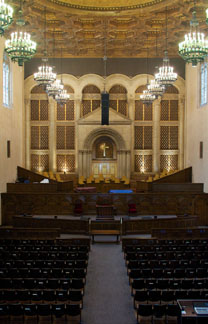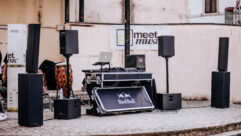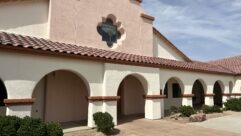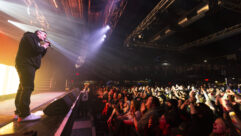
SVC Podcast – Show Notes – Show 174-1
In this edition of the SVC Podcast, Contributing Editor Bennett Liles talks with Duke DeJong of CCI Solutions in Olympia, Washington regarding their installation of an all new L-Acoustics sound system for the First Baptist Church of Los Angeles. Soaring ceilings and a challenging sound environment had presented problems for quite some time and the church has worked its way through a number of sound setups but the L-Acoustics system and the CCI Solutions installation gave the church a system they can rely on for many years to come.
For Part 2
Links of interest:
- CCI Solutions in Olympia, Washington
- The First Baptist Church of Los Angeles
- L-Acoustics, makers of speaker systems and amplified controllers
Download Podcast Here:
https://s3.amazonaws.com/nb-svc/public/public/174-1_FBCLA_CCI_Solutions_…
This is the SVC Podcast from Sound & Video Contractor Magazine with Duke DeJong of CCI Solutions. Show notes and equipment links for the podcast are on the web site of Sound & Video Contractor Magazine at svconline.com.
The First Baptist Church of Los Angeles is a huge place and a lot of different groups use it. Until recently, they were all dragging different sound systems in and out. CCI Solutions introduced them to an L-Acoustics system that changed everything. Duke DeJong is here to give us the story on the sound system all of the groups can now use. That’s coming up on the SVC Podcast.
Hi, Duke. Nice to have you on the SVC Podcast from CCI Solutions.
Hey, glad to be here.
And we talked about a year ago I think it was, when we did one of these previously so what’s been happening since then out there in Olympia, Washington?
Well, not a lot here, but we’ve been all over the country doing projects for a lot of different churches and performing arts centers up and down the west coast. And we’ve had a lot happening Iowa to Indiana as well as a few on the east coast. So we’re just keeping busy and helping churches and venues wherever we can. [Timestamp: 1:20]
Well, that’s got to feel a little like hanging it over the edge when you’re so far from home and taking on some projects that are that detailed, you can’t just run back down the street and pick up something from the office.
We definitely have to pay attention when we’re onsite and focus on getting all the details that we need in just a few trips. But you know, the reality is for the most part we work with architects who know their stuff and general contractors who have a job to do and get their end of it done. So for the most part we find when we get on a good team the distance really doesn’t play much into it. It’s a minor inconvenience. [Timestamp: 1:54]
We’ve apparently got a good one here with the First Baptist Church of Los Angeles. That sounds like a very big church with a long history and it seems that not all of that has been smooth sailing as far as the sound system.
Yeah.
Did they have a number of different solutions that they were trying along the way?
This is a church, not quite a 100-year-old building, but it’s a very, very old, oversized kind of gothic-style cathedral-style building just right outside of Korea Town in downtown L.A. And it’s a beautiful, beautiful facility but 1,500 seats, acoustics are as bad as you think they are. Nearly impossible to get up to the ceiling. So the P.A. we walked into the main P.A. looks like it was probably a solid 20 years old or so. It was kind of a big horn cluster. It was definitely something we haven’t seen in a while. And they had stopped using it and so instead of having somebody to come in to do it right what they started doing was kind of putting in a ground-stacked P.A. with a couple of speakers on sticks and a little console. But even though they’ve got a large, large venue, the guys who own the building are actually not a very large church so they don’t even fill a quarter of the auditorium for their services. And so what they’ve done is they rent it out to a number of other churches through the week. So Sunday morning they meet. Sunday afternoon there’s a Spanish church that meets in there. On Saturdays and some other times a week there’s a Korean church that meets in there. And of course everybody had their own systems. And so when we walked in, you know you see this 20-plus year old P.A. flown, but then you see all these ground-stacked conglomerations over on the side as well. So it was just kind of a fascinating experience to walk in there and to listen to some of their vision for the space, one of which was to just simplify all of it for various reasons. But with three different churches using the venue and they also rent it out for movie shoots and TV shoots on occasion – they just wanted everything cleaned up, simplified and one system that everybody could use. And it had to be good enough for the most rocking of the Spanish service, but also clean and very, very intelligible for the more liturgical style of church. It was a very unique project for sure, both in the building and the needs by the client, but it turned out really well. [Timestamp: 4:16]
Sounds like there may have been a project just getting some old equipment out before the installation of the L-Acoustics system could even get started.
Well, really it wasn’t. It was all just kind of thrown up on the corners of the stages. So I mean it’s exactly what you think of when you think of a couple of smaller churches just kind of renting a venue and throwing a P.A. up, except for times three. So that part was super, super simple. The part that was complicated was the – I don’t remember the exact height of the ceiling, but it was at least 50-60 feet. So getting up to the ceiling and putting together a rigging structure for an array to hang in the center of the room, that was definitely the most fun. [Timestamp: 4:58]
Well, after I finally got up to that height I don’t think I’d want to be there anymore.
Yeah, I wouldn’t blame you. I wouldn’t be doing it either. The good news is there was attic space above the ceiling so our guys were able to get up there and work. And both put the structure in and then drop down what was needed to hand the array from. So we’ve had worse projects for sure. It’s not like we had to stack scaffold upon scaffold to get up there or anything. But it’s still an adventure any time you’re hanging an array from 60 feet up in the air in a nearly 100-year-old building. [Timestamp: 5:34]
That is interesting because it’s usually the smaller churches that you find bringing equipment in and out for temporary sound setups but to have that going on in such a big place has to be a special experience.
Yeah, you know, and it’s survival. When you have three churches who are all a couple hundred people meeting in the same building and it’s easy to get territorial with no, you can’t use my stuff and we don’t want to use your stuff because it’s not good enough and whatever. I was really impressed by the folks who actually own the building because they were really thinking forward going how do we make this a great venue for everybody who’s using it? How do we set everybody up for success? We want everybody to be able to use the same thing. We want it to be clean. We want it to be easy. We walked away really impressed by the church, passionate in setting a venue up that would work for everybody who uses it. [Timestamp: 6:22]
And is that what led you to choose the L-Acoustics system or was it just familiar gear to you?
We’ve been using L-Acoustics quite a bit over the last few years. We’ve become very familiar with all of their speakers and just love them. I mean they’ve always worked well for us no matter what the venue. We looked at a couple of different solutions. With the extremely high ceilings and some of the acoustical challenges of the room we did actually look into some steerable type of speaker products and in some ways would have loved to have gone there, but they just didn’t have $200-$300K to put into a speaker system. So instead we ended up looking at the L-Acoustics KIVA arrays. Those gave us really, really good coverage front to back of the room. This is basically a 1,500-seat-ish long, rectangular room. And so covering from front to back was obviously a major, major topic and the depth that they have in that room. We ended up with a little bit more coverage on the sidewalls than we were hoping for, but the good news is none of the churches that are there really push the P.A. so much that the room falls apart acoustically. That’s something we hope we get to do here in the future phase is tame down some of the reflections of the sidewalls. Like I said, we would have loved to have done it with some kind of steerable speaker system, but the budget just was not there. [Timestamp: 7:45]
With that much equipment being hauled in and out and connected by so many different people it may have either caused or experienced some problems with power. Did you have to make any changes to the electrical situation?
We didn’t. Fortunately there was enough power there. The bigger challenge from a wiring perspective was getting the wire from the amp racks all the way up to the attic and then drop back down through the speakers. So wire paths, as you can imagine, were not readily available for us so we had to get a little creative on that part. But power we were good, but getting signal to the speakers, that was definitely a little trickier. [Timestamp: 8:22]
It looks as though there were some initial concerns by the clients when they saw the relatively small size of the main array and the X8 fills. It seems they thought the L-Acoustics system might have more than it could handle with the size of the place.
Right. Right. Yeah, the church who owns it meets Sunday mornings. They loved how compact it was and how high we were able to keep it so that from a sight line perspective it wasn’t terribly obtrusive. The first weekend that the Spanish ministry came in they were definitely skeptical of the P.A. being able to keep up. And one of our guys was there for the sound check and for the service and they just kind of kept looking at it going, “Can we go louder? Can we go louder?” And our guys kept looking at the amps going, “You’ve got plenty of room. Keep going.” And it finally got to a point where they had pushed it to a point where they thought it was plenty loud and he kind of looked back at him and it’s like, “Louder still?” And he says, “Yeah, you’ve still got 10 dB more headroom.” Fortunately they didn’t keep turning it up because that would have just sounded bad at that point. But those little KIVA boxes are really deceptive because they are small, in a dual six enclosure, but man those things pack a punch. [Timestamp: 9:35]
Yeah, I noticed also that they have some balconies up there on the sides.
There’s some side coves both in the balcony and underneath the balcony and those have been used over the years for different things like choirs and kind of some special area seating. And so the main array did not cover those areas so we did just a little bit of some side fills for those areas. Fortunately with L-Acoustics their coaxial series of speakers, we were able to take some of those speakers and the X8’s and fill in some of those areas and keep a real similar sonic signature which is always a big deal for us. We want that consistent experience everywhere you go. So anytime we can take any kind of two-way enclosure and it sounds similar to what’s happening with the main array we’re happy campers. [Timestamp: 10:20]
Well, it sounds like that wasn’t the easiest job to pull off with so many people using that church with their own sound systems. In Part 2 we’ll get into some of the details on exactly where everything is and how it works. Duke DeJong from CCI Solutions in Olympia, Washington. See you then.
Thanks for joining us on the SVC Podcast. Show notes and equipment links are on the website of Sound & Video Contractor Magazine at svconline.com. Next week Duke will give us more details on the all new L-Acoustics sound system at the First Baptist Church of Los Angeles. That’s next time on the next SVC Podcast.










